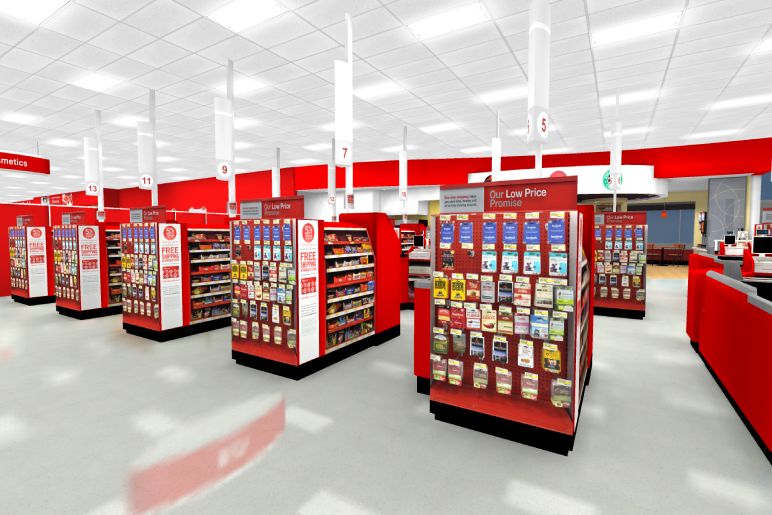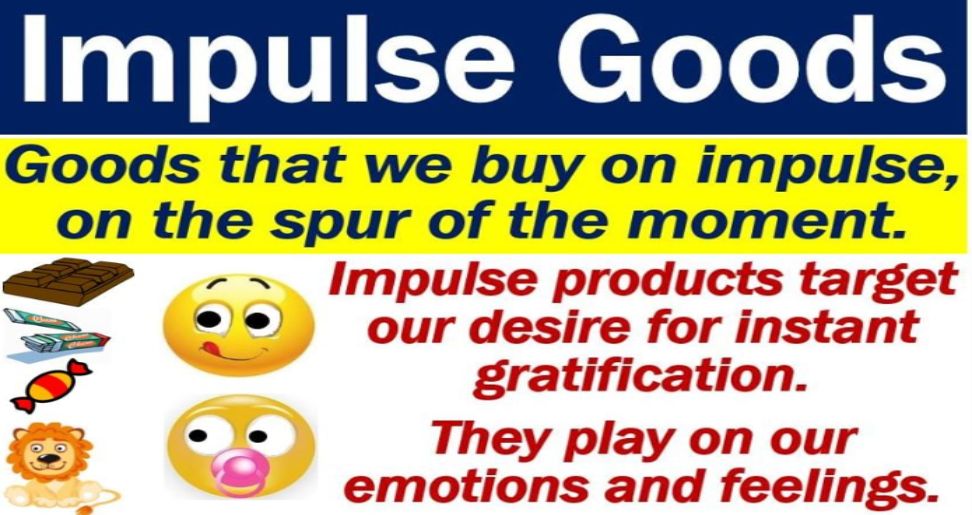Impulse items are products that consumers purchase without prior planning or consideration.
Unlike planned purchases, these items are bought on a whim, often driven by emotions, desires, or the immediate environment. They typically fall into the category of non-essential goods, and their purchase is often spontaneous and unplanned.
Essential, emergency, and impulse goods

Essential, emergency, and impulse goods represent distinct categories of consumer products based on purchase behavior and necessity. Essential goods are staples consumed regularly, such as milk, bread, and toiletries. These items are planned purchases and form the core of household consumption. In contrast, emergency goods are acquired spontaneously due to unforeseen circumstances, like an umbrella during a downpour or medicine for a sudden ailment. These products address immediate needs and are often purchased at higher price points. Finally, impulse goods are unplanned purchases driven by desire or temptation, typically found near checkout counters.
Examples include candy, magazines, or small trinkets. Understanding these distinctions is crucial for businesses in tailoring their product offerings, marketing strategies, and store layouts to meet consumer demands effectively.
Impulse goods and marketers
Impulse goods are products purchased spontaneously without prior planning or consideration.
Unlike essential items, these are typically non-essential but desirable, often appealing to consumers’ immediate wants or desires. Marketers capitalize on this by strategically placing these items in high-traffic areas, employing eye-catching displays, and crafting compelling messages that evoke emotional responses. By understanding consumer psychology and leveraging persuasive techniques, marketers can effectively influence impulse buying behavior, transforming unplanned purchases into significant revenue streams.
Online shopping

Online shopping has revolutionized the way we consume goods and services. This digital marketplace offers unparalleled convenience, allowing consumers to browse and purchase a vast array of products from the comfort of their homes. With just a few clicks, individuals can access a global marketplace, compare prices, read product reviews, and make informed decisions. From electronics and fashion to groceries and home goods, the virtual shopping experience has expanded to encompass almost every conceivable item. While it eliminates the need for physical stores and often provides competitive pricing, online shopping also presents challenges such as product authenticity, delivery times, and the inability to physically examine items before purchase.
“Impulse goods,” examples sentences
Impulse goods are products purchased spontaneously without prior planning or consideration.
Unlike staple items bought regularly, these goods are often displayed strategically at checkout counters or near high-traffic areas to tempt consumers. Classic examples include candy, magazines, gum, and small toys. For instance, a shopper might impulsively grab a chocolate bar while waiting in line, or a customer browsing a store might be drawn to a brightly colored gadget and decide to buy it on a whim. Retailers leverage impulse buying behavior by creating visually appealing displays and strategic product placement to increase sales of these unplanned items.
Understanding the Psychology Behind Impulse Buying

Impulse buying is a complex behavior influenced by various factors, including:
- Visual Appeal: Visual appeal is the aesthetic quality of something that captivates and engages the viewer’s eye. It encompasses a harmonious blend of elements such as color, composition, balance, and contrast. Effective visual appeal evokes emotional responses, guiding attention, and creating a lasting impression. Whether it’s a piece of art, a product design, or a digital interface, strong visual appeal is essential for capturing and maintaining audience interest. It is achieved through careful consideration of visual hierarchy, the strategic arrangement of elements, and the understanding of color psychology to create a visually compelling experience.
- Emotional Triggers: Emotional triggers are specific stimuli that evoke intense emotional responses. These can be external factors like sights, sounds, smells, or touch, or internal thoughts, memories, or bodily sensations. When encountered, these triggers can rapidly shift a person’s emotional state, often without conscious awareness. The impact of emotional triggers varies widely, from mild irritation to overwhelming distress. Understanding and managing these triggers is crucial for emotional regulation and overall well-being, as they can significantly influence behavior, relationships, and physical health.
- Convenience: Convenience is the allure of effortless efficiency. It’s the digital age’s siren song, promising to streamline our lives with the click of a button or the tap of a screen. From grocery delivery that bypasses bustling aisles to ride-sharing services that negate the stress of traffic, convenience offers a tantalizing escape from life’s mundane tasks. Yet, while it undoubtedly saves time and energy, it also risks fostering a dependence on immediate gratification and a detachment from the tangible world. The true measure of convenience lies in its ability to enhance our lives without compromising our ability to appreciate the value of effort and connection.
- Price Perception: Price perception is the subjective value a consumer assigns to a product or service based on various factors rather than its objective monetary value. It’s influenced by brand image, quality perceptions, perceived scarcity, and psychological cues like pricing tactics (e.g., odd-even pricing, anchoring). Consumers often associate higher prices with superior quality, creating a price-quality relationship. However, this perception can be manipulated through effective marketing and branding. Understanding price perception is crucial for businesses to optimize pricing strategies, position products effectively, and build strong customer relationships based on perceived value rather than just cost.
Characteristics of Impulse Items
Impulse items typically share the following characteristics:
- Low price point: Low price point refers to the strategy of offering a product or service at a significantly lower cost compared to competitors. This tactic is often employed to attract price-sensitive consumers, increase market share, or stimulate demand. A low price point can be achieved through various means such as cost reduction, efficient production processes, or eliminating unnecessary expenses. However, it’s crucial to maintain product quality and value proposition to avoid compromising customer satisfaction. While a low price point can be a powerful tool, businesses must carefully consider its impact on profit margins and overall business strategy.
- Small size: Small size refers to dimensions that are considerably less than average or standard. It implies compactness, diminutive scale, and often a delicate or fragile nature. Objects characterized by small size might be easily portable, occupy minimal space, or require careful handling. This attribute can be desirable in various contexts, such as in electronics, fashion, or even biology, where it often correlates with efficiency, portability, or specialized functions. However, small size can also limit capacity or power, necessitating careful design and consideration of trade-offs. Ultimately, the value of small size depends on the specific application and the desired balance of advantages and constraints.
- High visibility: High visibility refers to the quality of being easily seen or noticed. It’s a crucial factor in various contexts, from safety apparel designed to stand out in low-light conditions to marketing strategies aimed at capturing attention. High visibility is often achieved through bright colors, reflective materials, or strategically placed elements that contrast with the background. Whether it’s a construction worker’s vest, a road sign, or a product advertisement, the principle remains the same: to enhance visibility and ensure clear perception by the observer.
- Emotional appeal: Emotional appeal is a persuasive technique that seeks to evoke strong feelings in an audience to influence their attitudes, beliefs, or actions. By tapping into emotions such as joy, fear, anger, love, or sympathy, speakers or writers can create a powerful connection with their listeners or readers. This connection can make an argument more compelling and memorable, as emotions often override logic. While emotional appeals should complement logical arguments, they can be particularly effective when addressing issues that resonate deeply with people’s values or personal experiences. However, it’s essential to use emotional appeals ethically and responsibly, avoiding manipulation or exploitation of audience vulnerabilities.
Read More :
Featured Image Source: https://tinyurl.com/56d8bvjb

